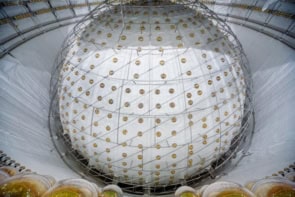A beam of neutrinos could be fired nearly ten thousand kilometres through the Earth in an experiment proposed by Fritz DeJongh at Fermilab. DeJongh hopes to persuade Japanese particle physicists to build a new detector at the SuperKamiokande site to analyse a beam of neutrinos sent by a powerful generator currently under construction at Fermilab in the US. Passing through so much matter should alter the beam in a way that makes it possible to establish the masses of the three different types of neutrino, and to study ‘charge-parity violation’ (arXiv.org/abs/hep-ex/0203005).
Neutrinos are difficult to study because they have very little mass and interact only weakly with matter. They also ‘oscillate’ between three possible ‘flavours’ – electron, muon and tau – each of which has a different mass. Previous observations of these oscillations have revealed the differences between these masses, but have not established the masses themselves.
But DeJongh believes that a ‘long-baseline’ experiment in which beams of neutrinos and anti-neutrinos are sent through the Earth could be combined with existing results to determine the masses of the three flavours. By travelling the 9300 kilometres from Fermilab to the SuperKamiokande detector in Japan, the beams would pass through enough matter to increase by a factor of 20 the number of oscillations in either the neutrino or the anti-neutrinos.
The amplified signal would also allow physicists to compare the different oscillation behaviour of neutrinos and anti-neutrinos. Earlier ‘short-baseline’ experiments have been unable to produce this effect because the beams passed through too little matter.
Such an experiment would also give fresh insights into ‘charge-parity violation’, a phenomenon proposed to explain why particles are not exact opposites of their anti-particles. Charge-parity violation could help to explain why there is more matter than anti-matter in the universe when the big bang is thought to have produced equal amounts of each.
According to DeJongh, construction of a new detector in Japan would need to begin around 2006 to coincide with the completion of the new beamline at Fermilab. He has already presented his idea to physicists in Japan, and is optimistic about the project although an agreement has yet to be reached. He concedes that particle physicists are likely to be sceptical until he provides more details.
“Our community as a whole is going through a process of considering the future,” DeJongh told PhysicsWeb, “and I think this is an exciting possible element of our roadmap”.
The SuperKamiokande site has already detected neutrinos from the KEK particle physics lab some 250 kilometres away, although the detector recently suffered an accident and is currently out of commission. There are also plans to send neutrino beams from the CERN particle physics lab in Geneva to the Gran Sasso underground lab 730 kilometres away in Italy, and from Fermilab near Chicago to the Soudan experiment, 710 kilometres away in Minnesota.



